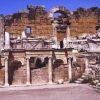
The ancient city of Hierapolis, the original site of Pamukkale, was known as the Holy City in archaeological literature because of the abundance of temples and other religious structures in the area. Although there is limited information on the origin of the city, it is known that the city was founded by Eumenes II, who named it after Bergama's mythical founder, Hiera (the wife of Telephos). It was an important centre during Roman and Byzantine periods, and was also a centre of Christianity since the 4th century.
Principal Remnants - Main Street and Doors
The colonnaded main street, 1km in length, divides the city into two sections from one end to the other. At both ends are monumental doors outside the Byzantine ramparts because huge sections of the doors were constructed during the Roman era. On the South Byzantine Door, dating back to 5 B.C., is an epitaph dedicated to Emperor Dominatian. The northern Byzantine Door, dating back to the same period, is at the junction between the road and the ramparts.
Ramparts
The city was encircled with walls around the north, east and south, in the 5th century B.C. 24 square towers were added, but the majority of these have since collapsed. Of the four entrances, two are the monumental doors and the other two are small.
Great Turkish Bath Complex
Now part of the Pamukkale Museum, the layout of the Roman Baths are typical to that era. A wide courtyard is found at the entrance, through which runs a rectangular area with large halls on either side. There is evidence suggesting that the interior's huge walls were covered with marble. At the north and south of the main complex, are two main halls essentially used for the private use of the Emperor, and for ceremonies. The remains of the baths date back to the 2nd century B.C., and the area is now covered with marble. A large section of the baths is currently on exhibiton at the Pamukkale Museum.
Apollion Temple
Near the museum, are the foundations of the Temple, constructed on the Plutonium spring and dedicated to Pluto, the God of the underworld. It still gives off deadly poisonous gases and in front of the temple, a grate has been installed over the underground entrance to the spring in order to prevent inquisitive visitors. It was the site of an ancient religious cave, where Apollo met the mother Goddess of Cybele. Suggest that she descended into the cave without being affected by the toxic fumes. The upper parts of the Temple date back to the 3rd century, and are accessible through a wide staircase.
Theatre
The restored Roman theatre dates back to the 2nd century, and the stage buildings and elaborate reliefs are in exceptionally good condition. Construction began in 62 A.D. by Flavius, two years after a large earthquake, and was completed in 206 A.D. It once had a capacity of around 12,000, and adorned with columns and statues which were unearthed during excavations. On the backstage walls are marble bas-reliefs. The theatre is still the venue for the annual International Pamukkale Song Festival in June, during which 7000 spectators can be seated.
Churches
In the city centre, structures a cathedral, a church with pillars are present. Two other churches belonging to the 6th and 7th centuries, with smaller chapels are situated at the northern end of the city.
Hierapolis Archeology Museum
The old Roman Baths, one of the largest structures in Hierapolis, have been exhibited in the Archaeological Museum since 1984. Inside are exhibits from excavations of the area.
 The ancient city of Hierapolis, the original site of Pamukkale, was known as the Holy City in archaeological literature because of the abundance of temples and other religious structures in the area. Although there is limited information on the origin of the city, it is known that the city was founded by Eumenes II, who named it after Bergama's mythical founder, Hiera (the wife of Telephos). It was an important centre during Roman and Byzantine periods, and was also a centre of Christianity since the 4th century.
The ancient city of Hierapolis, the original site of Pamukkale, was known as the Holy City in archaeological literature because of the abundance of temples and other religious structures in the area. Although there is limited information on the origin of the city, it is known that the city was founded by Eumenes II, who named it after Bergama's mythical founder, Hiera (the wife of Telephos). It was an important centre during Roman and Byzantine periods, and was also a centre of Christianity since the 4th century.